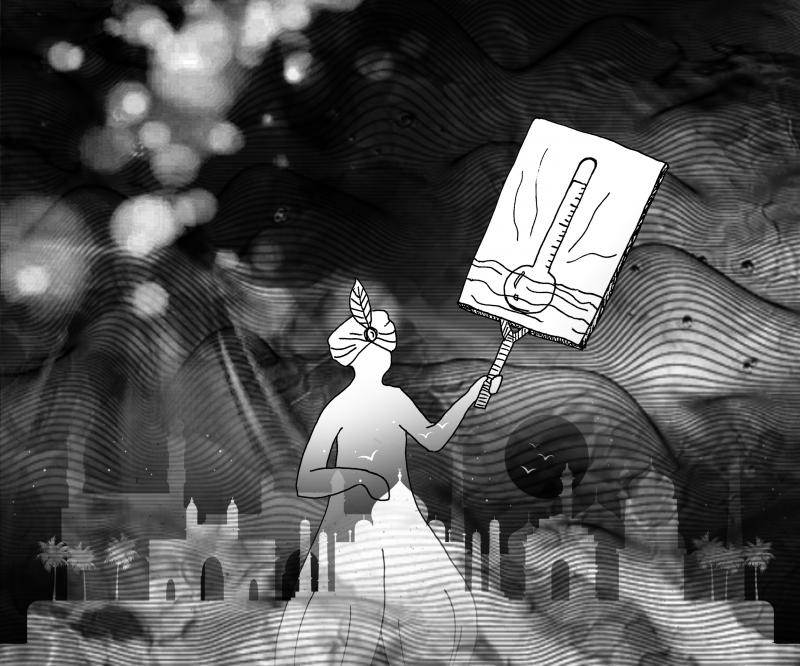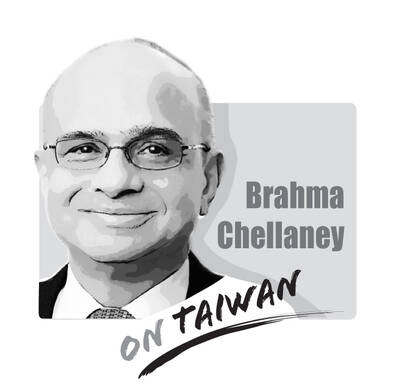New Delhi feels like it is on fire. The heat comes off the road in blistering waves, and the water that flows from the cold tap is too hot to touch. Daytime temperatures have hit 44°C and often do not fall below 30°C at night. A giant landfill on the outskirts of the capital spontaneously combusted a week ago, and the 17-story high dump that contains millions of tonnes of garbage continues to smolder, worsening the city’s already dangerously polluted air.
Daily power outages driven by a surge in demand for electricity have resulted in blackouts as long as eight hours in some parts of India, while coal stocks — the fuel that accounts for 70 percent of the nation’s electricity generation — are running low, prompting warnings of a fresh power crisis. The northern wheat crop is scorched. It was the hottest March in 122 years. Spring just did not happen, and those extreme temperatures continued into last month and this month. Moreover, it is not until next month that the monsoon is expected to arrive and provide any kind of relief.
What is most alarming about this heat wave is that it is not so much a one-time ordeal as a taste of things to come as the effects of global warming push India and its neighbors to levels where the climate is a core threat to human health.

Illustration: Tania Chou
The most worrying weather measurement is not the heat typically reported in forecasts, but the wet-bulb temperature, which combines heat and humidity to indicate how much evaporation can be absorbed into the air. At wet-bulb temperatures above 35°C we become unable to reduce our temperature via sweating and will suffer potentially fatal heatstroke after only a few hours, even with shade and water. Similar effects can result for those working outdoors when wet-bulb temperatures exceed 32°C, and measures as low as 28°C caused tens of thousands of deaths in the European and Russian heat waves of 2003 and 2010 respectively.
Humidity falls as temperature rises, so such events were once thought to be extraordinarily rare. One 2018 study concluded that the most severe temperatures of close to 35°C “almost never occur in the current climate.” However, a closer analysis of data from weather stations in 2020 suggests they are already happening relatively frequently, particularly in the heavily populated belt from the Persian Gulf through Pakistan and northwest India.
Just 12 percent of India’s 1.4 billion citizens have access to air-conditioning, which means hundreds of millions of people are simply unable to cool themselves when their bodies reach the point of heatstroke. It is a situation mirrored in neighboring Pakistan, which is experiencing similarly catastrophic heat-wave conditions. Daily wage earners, who toil in the fields, work in factories and construction, sweep streets and build roads, have no escape.
Government data show that multiple regions of India have already been edging close to critical wet-bulb temperatures over the past week, although the maximum humidities have not necessarily been occurring at the same time as the peak temperatures. In eastern Odisha state, peak temperatures and humidities in parts of the capital Bhubaneswar on Sunday would have produced wet-bulb temperatures of 36.6°C if they happened at the same time, the data show. Kolkata, a city larger than Los Angeles or London, on Friday last week also saw conditions that would have hit 35°C if simultaneous.
The risk is that, even if the most hazardous levels are avoided in the current heat wave, each hot season is a fresh roll of the dice on whether a freak event would occur that would lead to vast numbers of deaths. The odds lengthen with each passing year. The world is in the grip of a La Nina climate cycle, which typically brings cooler summer weather to India. When that next flips to El Nino, the risks would ramp higher still.
That the government has not declared a national disaster and rolled out an appropriate response will come as no surprise to those who lived through the nation’s deadly COVID-19 pandemic.
India does have a “National Action Plan on Heat Related Illnesses” and the federal government on Sunday issued an advisory to states urging them to ensure hospitals were ready to deal with an expected surge in demand. However, given that the India Meteorological Department (which started collecting nationwide records in 1901) has been raising the alarm with heat-wave warnings since April 25, it all feels a little underdone.
Recommended measures such as whitewashing roofs to cool building interiors would be insufficient to deal with a major heat wave. Advice to ensure secure power supply to health centers would not help if heat and the load from millions of air-conditioners cause the power grid to fall over when it is most needed.
A year ago, India was reeling from a deadly COVID-19 wave, as people took to social media to beg for oxygen and hospitals turned away critically ill people gasping for breath while the underfunded health system collapsed under the weight of decades of government neglect. The WHO estimated that at least 4 million Indians died in that carnage, way beyond the official figure of just under 524,000 fatalities. (The government of Indian Prime Minister Narendra Modi disputes that finding, even though it has been replicated by other experts.)
We will never know, as the majority of deaths are not recorded in the world’s largest democracy. So many of those who expire from the heat, dying on the baking pavements they sleep on or in the unbearably hot slums on the city’s fringes, will similarly go uncounted.
That means governments — state and federal — will never properly plan for heat waves, nor will they invest in the infrastructure and systems needed to provide relief and help reduce the intensity of these climate change-driven disasters. With a warming planet and the increasing intensity of extreme weather events, that has to change.
Ruth Pollard is a columnist and editor with Bloomberg Opinion. David Fickling is a Bloomberg Opinion columnist covering commodities, as well as industrial and consumer companies.
Recently, China launched another diplomatic offensive against Taiwan, improperly linking its “one China principle” with UN General Assembly Resolution 2758 to constrain Taiwan’s diplomatic space. After Taiwan’s presidential election on Jan. 13, China persuaded Nauru to sever diplomatic ties with Taiwan. Nauru cited Resolution 2758 in its declaration of the diplomatic break. Subsequently, during the WHO Executive Board meeting that month, Beijing rallied countries including Venezuela, Zimbabwe, Belarus, Egypt, Nicaragua, Sri Lanka, Laos, Russia, Syria and Pakistan to reiterate the “one China principle” in their statements, and assert that “Resolution 2758 has settled the status of Taiwan” to hinder Taiwan’s

Can US dialogue and cooperation with the communist dictatorship in Beijing help avert a Taiwan Strait crisis? Or is US President Joe Biden playing into Chinese President Xi Jinping’s (習近平) hands? With America preoccupied with the wars in Europe and the Middle East, Biden is seeking better relations with Xi’s regime. The goal is to responsibly manage US-China competition and prevent unintended conflict, thereby hoping to create greater space for the two countries to work together in areas where their interests align. The existing wars have already stretched US military resources thin, and the last thing Biden wants is yet another war.
As Maldivian President Mohamed Muizzu’s party won by a landslide in Sunday’s parliamentary election, it is a good time to take another look at recent developments in the Maldivian foreign policy. While Muizzu has been promoting his “Maldives First” policy, the agenda seems to have lost sight of a number of factors. Contemporary Maldivian policy serves as a stark illustration of how a blend of missteps in public posturing, populist agendas and inattentive leadership can lead to diplomatic setbacks and damage a country’s long-term foreign policy priorities. Over the past few months, Maldivian foreign policy has entangled itself in playing
A group of Chinese Nationalist Party (KMT) lawmakers led by the party’s legislative caucus whip Fu Kun-chi (?) are to visit Beijing for four days this week, but some have questioned the timing and purpose of the visit, which demonstrates the KMT caucus’ increasing arrogance. Fu on Wednesday last week confirmed that following an invitation by Beijing, he would lead a group of lawmakers to China from Thursday to Sunday to discuss tourism and agricultural exports, but he refused to say whether they would meet with Chinese officials. That the visit is taking place during the legislative session and in the aftermath